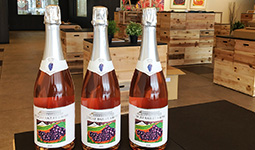Home > Highlighting JAPAN > Highlighting Japan February 2017 > New Pioneers of Local Development
Highlighting JAPAN


Let There Be Wine
A new winery in Fukushima Prefecture is helping to revive the local fruit-farming industry while bringing delicious new products to the Japanese table.
The Tohoku region, which produces a range of agricultural products such as rice, vegetables and fruit, suffered significant damage from the Great East Japan Earthquake and subsequent tsunami of 11 March 2011. Now, almost six years later, agriculture in the Tohoku area is showing signs of gradual recovery. Against this background, a number of projects have identified new agricultural possibilities across the region. One such project is the Fukushima Ouse Winery in Koriyama City, Fukushima, a prefecture known for fruit growing.
The Fukushima Ouse Winery was established in February 2015 upon the conclusion of a collaboration agreement between the Mitsubishi Corporation Disaster Relief Foundation and the Koriyama City government. The winery was established with the aim of supporting the stimulation of sixth industry agri-business in Fukushima and creating added value to the prefecture’s agricultural sector through the production and sales of wines and liqueurs.
“We did not necessarily intend to create a winery in the beginning. The decision to produce fruit wine in order to increase the added value of locally produced fruit was arrived at after discussions with people involved in local agriculture,” says Takeyuki Nakagawa, the director of the winery who acts as the project leader at the Foundation.
“When we concluded the collaboration agreement with Koriyama City, our target was to have the first product shipped in March 2016, one year later, in time to mark the fifth anniversary of the Earthquake. To achieve that, we had to brew wine from fruit harvested in the autumn of 2015 and complete the winery before then. We were literally racing against the clock.”
Construction started in May 2015. The winery, equipped with the latest facilities, including German-made distillery machinery, was completed just five months later in October, and an experienced manager was recruited to oversee the brewing process. While the winery was being constructed, the Foundation also set up an office in Koriyama, allowing its staff to remain in close touch with fruit farmers. The staff deepened their relationship of trust with the community through their continued engagement in a number of activities such as working with farmers to create new vineyards by cultivating abandoned land.
“Our mission is to continuously produce high-quality fruit wine and show the world the quality of the fruit grown in Fukushima,” says Nakagawa. “Therefore, we are working with farmers who can grow high-quality fruit and can pass the tradition on to younger farmers.”
In March 2016, the winery was successfully able to ship, as initially planned, 500 bottles of Muscat Bailey A Rosé 2015 sparkling wine made from grapes grown in Fukushima, an original wine featuring a fresh and sweet aroma. The winery was also able to dispatch 5,000 bottles of Cider 2015 brewed from apples grown in Fukushima. The cider offers an excellent blend of rich, sweet and acidic flavors.
In November 2016, the winery also started to sell wine and offer wine tasting, in addition to releasing Pêche and Poire Japonaise, liqueurs made from Fukushima-grown peaches and pears. In February 2017, 2,000 bottles of each product were fermented for consumption.
The products are mainly sold through hotels, restaurants and tourist facilities in Fukushima. The winery aims to increase production gradually and to expand its sales channels in other regions including the Tokyo metropolitan area.
Additionally, the winery has begun working with local farmers to select three types of grapes, including Merlot and Chardonnay, which go well with Koriyama’s weather and climate, to produce wine. Farmers engaged in grape cultivation have set up workshops and are reaching out to wine masters and visiting vineyards in Hokkaido and other parts of the Tohoku region to exchange views and to examine how grapes are grown with the aim of having their first harvest in three years.
“The winery produced 10,000 bottles of wines and liqueurs in its first year, but production will be gradually increased, eventually reaching a volume of 70,000 to 80,000 bottles per year,” says Nakagawa. “The Foundation will continue to provide support as we seek to solidify business infrastructure in the initial stages, but at some point in the future, we expect to hand the business over to the community.”
© 2009 Cabinet Office, Government of Japan








